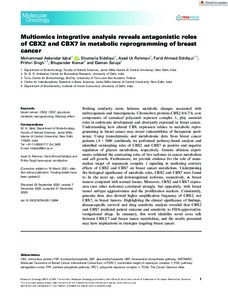Multiomics integrative analysis reveals antagonistic roles of CBX2 and CBX7 in metabolic reprogramming of breast cancer
Rehman Asad Ur; Saluja Daman; Kumar Bhupender; Siddiqui Farid Ahmad; Singh Prithvi; Siddiqui Shumaila; Iqbal Mohammad Askandar
Multiomics integrative analysis reveals antagonistic roles of CBX2 and CBX7 in metabolic reprogramming of breast cancer
Rehman Asad Ur
Saluja Daman
Kumar Bhupender
Siddiqui Farid Ahmad
Singh Prithvi
Siddiqui Shumaila
Iqbal Mohammad Askandar
WILEY
Julkaisun pysyvä osoite on:
https://urn.fi/URN:NBN:fi-fe2021042822590
https://urn.fi/URN:NBN:fi-fe2021042822590
Tiivistelmä
Striking similarity exists between metabolic changes associated with embryogenesis and tumorigenesis. Chromobox proteins-CBX2/4/6/7/8, core components of canonical polycomb repressor complex 1, play essential roles in embryonic development and aberrantly expressed in breast cancer. Understanding how altered CBX expression relates to metabolic reprogramming in breast cancer may reveal vulnerabilities of therapeutic pertinence. Using transcriptomic and metabolomic data from breast cancer patients (N > 3000 combined), we performed pathway-based analysis and identified outstanding roles of CBX2 and CBX7 in positive and negative regulation of glucose metabolism, respectively. Genetic ablation experiments validated the contrasting roles of two isoforms in cancer metabolism and cell growth. Furthermore, we provide evidence for the role of mammalian target of rapamycin complex 1 signaling in mediating contrary effects of CBX2 and CBX7 on breast cancer metabolism. Underpinning the biological significance of metabolic roles, CBX2 and CBX7 were found to be the most up- and downregulated isoforms, respectively, in breast tumors compared with normal tissues. Moreover, CBX2 and CBX7 expression (not other isoforms) correlated strongly, but oppositely, with breast tumor subtype aggressiveness and the proliferation markers. Consistently, genomic data also showed higher amplification frequency of CBX2, not CBX7, in breast tumors. Highlighting the clinical significance of findings, disease-specific survival and drug sensitivity analysis revealed that CBX2 and CBX7 predicted patient outcome and sensitivity to FDA-approved/investigational drugs. In summary, this work identifies novel cross talk between CBX2/7 and breast tumor metabolism, and the results presented may have implications in strategies targeting breast cancer.
Kokoelmat
- Rinnakkaistallenteet [19204]
